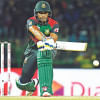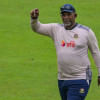The Mash Effect

A common theme running through most analyses of Bangladesh's sharp reversal in performance to outplay West Indies in Sunday's first ODI in Guyana has been the change in format from Tests to ODIs, which the Tigers are much more comfortable with. The most important factor, however, may have been the presence in the dressing room and on the field of one of the most remarkable cricketers in the world. It helps too that he is the captain.
While the Tigers were being embarrassed in the Test matches, Mashrafe Bin Mortaza was in Bangladesh beset by much graver concerns as his wife was seriously ill. Her condition had put his departure for West Indies in doubt. It was eventually delayed and he missed out on the practice match on Thursday. For a man with seven knee operations and one who had not bowled competitively since the end of the Dhaka Premier League in April, he could have been forgiven for not bowling in the first ODI, but he was the best bowler on either side as his figures of four for 37 attest.
But even that is not as important as the Mash effect. It was not the first time that Mashrafe's arrival has produced an uptick in batting performance that saw Tamim Iqbal, Shakib Al Hasan and Mushfiqur Rahim combine to post Bangladesh's highest total in the West Indies. After a similarly sordid batting performance in the two Tests in South Africa last October, Bangladesh scored 278 for seven -- their highest score in South Africa -- in the first ODI.
It was a function of their opposition's much greater class and alien wickets that they went on to lose the match by 10 wickets, but at least the batting group -- upon whose mood swings the team's fortunes often rise and fall -- had overcome the siege mentality. It would be lazy to think that Mashrafe's cheerful demeanour is all that was needed. That is part of it but the whole effect is much more.
That he was in West Indies at all speaks more about his commitment to the cause than his bowling figures. No one could have faulted him if he had sat out the tour. But he perhaps knew that after the Test debacle -- which had attached to it the now inevitable public tongue lashing from the board president -- morale would be low.
Then there is his evolution as a bowler. There is no better example of a thinking bowler currently in operation in world cricket. He was once a tearaway quick, memorably bowling in excess of 145kmph in the 2007 World Cup knockout blow to India in West Indies. But four years later, ahead of a home World Cup, his failing knees had caused him to tearfully withdraw from the tournament. In the aftermath, in a culture dominated by talk of the 'natural game', Mashrafe changed his nature and nurtured variations. With considerably reduced pace, he kept no less a man than Chris Gayle quiet in the victorious home series of 2012, allying his swing and accuracy to clever changes of pace.
That is what he did on Sunday, even as he bowled off a reduced run-up to go easy on his tortured knees. That he walks, let alone runs, on those knees tells other players that it is okay to struggle through any niggles they may feel on the field.
His 'spot-on' bowling changes, as Tamim put it after the match, has long set the example of being alive to the match situation that Bangladeshi players are often guilty of not doing. Very rarely is Mashrafe seen implementing a preset plan while the ground realities point the other way.
"Nothing special, just tried to say that play with your hearts -- you're playing for your nation. Whatever's gone is gone," said Mashrafe after the match when asked how he pumped his boys into a side unrecognisable from the one that played the Tests.
On this there is disagreement. When it comes to Mashrafe, whose qualities as a leader overshadow his considerable ability as a bowler, there is very little that is not special.

 For all latest news, follow The Daily Star's Google News channel.
For all latest news, follow The Daily Star's Google News channel. 








Comments